Experimental and Numerical Investigation of CMT Wire and Arc Additive Manufacturing of 2205 Duplex Stainless Steel
Abstract
:1. Introduction
2. Methods and Experimental Design
2.1. Materials and Instruments
2.2. CMT Wire and Arc Additive Manufacturing
3. Finite Element Analysis
3.1. Finite Element Model
3.2. Selection of Heat Source
3.3. Heat Conduction Analysis
3.4. Boundary Condition
4. Results and Discussion
4.1. Experimental Result Analysis
4.1.1. Mechanical Properties
4.1.2. Microstructure Evolution
4.2. Simulation Result Analysis
4.2.1. Calibration of the Finite Element Model
4.2.2. Temperature Field Analysis
4.2.3. Stress Field Analysis
5. Conclusions
- The microhardness of 2205 duplex stainless steel is about 235.19 HV0.1. The ultimate tensile strength, yield strength and elongation at break of reciprocating additive along BD are 856.73 MPa, 710.5 MPa and 42.35%, respectively. The microstructure of 2205 duplex stainless steel is mainly needle austenite, intragranular austenite, grain boundary austenite, Widmanstatten austenite and secondary austenite.
- By comparing the temperature fields of SDM and RM additive, with the increase of deposited layers, the heat accumulation of SDM additive is greater than that of RM additive, which can effectively verify the collapse phenomenon of SMD additive during the actual additive process, while the appearance of RM is well-formed.
- The different paths of the additions also have different effects on the stress field. The simulation analysis shows that the stress at the bottom and top of the equivalent stress deposition layer are smaller and the middle stress is larger for different paths.
- By comparing the longitudinal and transverse stresses along the incremental scanning direction and incremental height direction for different paths, the transverse stresses along the incremental scanning direction are both compressive stresses, and the SDM compressive stresses are greater than the RM compressive stresses. The longitudinal stresses along the increment height direction, near the top of the increment specimen, the tensile stresses of SDM are greater than the tensile stresses of RM.
Author Contributions
Funding
Institutional Review Board Statement
Informed Consent Statement
Data Availability Statement
Conflicts of Interest
References
- Huang, R.; Riddle, M.; Graziano, D.; Warren, J.; Das, S.; Nimbalkar, S.; Cresko, J.; Masanet, E. Energy and emissions saving potential of additive manufacturing: The case of lightweight aircraft components. J. Clean Prod. 2016, 135, 1559. [Google Scholar] [CrossRef] [Green Version]
- Li, T.; Li, R.; Chang, T.; Ye, X.; Wang, F. Texture evolution and properties analysis of R60702 pure zirconium joint by fiber laser welding. Mater. Charact. 2021, 182, 111581. [Google Scholar] [CrossRef]
- Li, T.; Xu, J.; Bi, X.; Li, R. Microstructure evolution and crack propagation mechanism during laser lap welding of Ti6Al4V and DP780 steel with CoCrNi powder. Mater. Design 2022, 223, 111126. [Google Scholar] [CrossRef]
- Zhao, Y.; Li, R.; Wu, M.; Yue, H.; Li, T.; Chen, Y. Effect of c-BN on the microstructure and high temperature wear resistance of laser cladded Ni-based composite coating. Surf. Coat. Technol. 2021, 421, 127466. [Google Scholar] [CrossRef]
- Yuan, W.; Li, R.; Zhu, Y.; Zhao, Y.; Zhang, X.; Liu, B.; Zhang, B. Structure and properties of nickel-plated CNTs/Fe-based amorphous composite coatings fabricated by high-speed laser cladding. Surf. Coat. Technol. 2022, 438, 128363. [Google Scholar] [CrossRef]
- Williams, S.W.; Martina, F.; Addison, A.C.; Ding, J.; Pardal, G.; Colegrove, P. Wire+ arc additive manufacturing. Mater. Sci. Tech.-Lond 2016, 32, 641. [Google Scholar] [CrossRef] [Green Version]
- Yilmaz, O.; Ugla, A.A. Shaped metal deposition technique in additive manufacturing: A review. Proc. Inst. Mech. Eng. Part. B J. Eng. Manuf. 2016, 230, 1781. [Google Scholar] [CrossRef]
- Martina, F.; Ding, J.; Williams, S.; Caballero, A.; Pardal, G.; Quintino, L. Tandem metal inert gas process for high productivity wire arc additive manufacturing in stainless steel. Addit. Manuf. 2019, 25, 545. [Google Scholar] [CrossRef] [Green Version]
- Cunningham, C.R.; Flynn, J.M.; Shokrani, A.; Dhokia, V.; Newman, S.T. Invited review article: Strategies and processes for high quality wire arc additive manufacturing. Addit. Manuf. 2018, 22, 672. [Google Scholar] [CrossRef]
- Bi, X.; Li, R.; Hu, Z.; Gu, J.; Jiao, C. Microstructure and Texture of 2205 Duplex Stainless Steel Addi-Tive Parts Fabricated by the Cold Metal Transfer (CMT) Wire and Arc Additive Manufacturing (WAAM). Metals 2022, 12, 1655. [Google Scholar] [CrossRef]
- Yilmaz, O.; Ugla, A.A. Microstructure characterization of SS308LSi components manufactured by GTAW-based additive manufacturing: Shaped metal deposition using pulsed current arc. Int. J. Adv. Manuf. Technol. 2017, 89, 13. [Google Scholar] [CrossRef]
- Pickin, C.G.; Williams, S.W.; Lunt, M. Characterisation of the cold metal transfer (CMT) process and its application for low dilution cladding. J. Mater. Process. Tech. 2011, 211, 496. [Google Scholar] [CrossRef] [Green Version]
- Ruiz-Vela, J.I.; Montes-Rodríguez, J.J.; Rodríguez-Morales, E.; Toscano-Giles, J.A. Effect of cold metal transfer and gas tungsten arc welding processes on the metallurgical and mechanical properties of Inconel® 625 weldings. Weld. World 2019, 63, 459. [Google Scholar] [CrossRef]
- Hengsbach, F.; Koppa, P.; Duschik, K.; Holzweissig, M.J.; Burns, M.; Nellesen, J.; Tillmann, W.; Tröster, T.; Hoyer, K.; Schaper, M. Duplex stainless steel fabricated by selective laser melting—Microstructural and mechanical properties. Mater. Design 2017, 133, 136. [Google Scholar]
- Wang, Z.; Palmer, T.A.; Beese, A.M. Effect of processing parameters on microstructure and tensile properties of austenitic stainless steel 304L made by directed energy deposition additive manufacturing. Acta Mater. 2016, 110, 226. [Google Scholar] [CrossRef] [Green Version]
- Nikam, P.P.; Arun, D.; Ramkumar, K.D.; Sivashanmugam, N. Microstructure characterization and tensile properties of CMT-based wire plus arc additive manufactured ER2594. Mater. Charact. 2020, 169, 110671. [Google Scholar] [CrossRef]
- Mukherjee, T.; Zhang, W.; DebRoy, T. An improved prediction of residual stresses and distortion in additive manufacturing. Comp. Mater. Sci. 2017, 126, 360. [Google Scholar] [CrossRef] [Green Version]
- Guo, J.; Fu, H.; Pan, B.; Kang, R. Recent progress of residual stress measurement methods: A review. Chinese J. Aeronaut. 2021, 34, 54. [Google Scholar] [CrossRef]
- Zhang, J.; Wang, X.; Paddea, S.; Zhang, X. Fatigue crack propagation behaviour in wire+arc additive manufactured Ti-6Al-4V: Effects of microstructure and residual stress. Mater. Design 2016, 90, 551. [Google Scholar] [CrossRef]
- Luo, Z.; Zhao, Y. A survey of finite element analysis of temperature and thermal stress fields in powder bed fusion Additive Manufacturing. Addit. Manuf. 2018, 21, 318. [Google Scholar] [CrossRef] [Green Version]
- Bertini, L.; Bucchi, F.; Frendo, F.; Moda, M.; Monelli, B.D. Residual stress prediction in selective laser melting. Int. J. Adv. Manuf. Technol. 2019, 105, 609. [Google Scholar]
- Cook, P.S.; Murphy, A.B. Simulation of melt pool behaviour during additive manufacturing: Underlying physics and progress. Addit. Manuf. 2020, 31, 100909. [Google Scholar] [CrossRef]
- Li, R.; Wang, G.; Ding, Y.; Tang, S.; Chen, X.; Dai, F.; Wang, R.; Song, H.; Zhang, H. Optimization of the geometry for the end lateral extension path strategy to fabricate intersections using laser and cold metal transfer hybrid additive manufacturing. Addit. Manuf. 2020, 36, 101546. [Google Scholar] [CrossRef]
- Zhou, J.; Barrett, R.A.; Leen, S.B. Three-dimensional finite element modelling for additive manufacturing of Ti-6Al-4V components: Effect of scanning strategies on temperature history and residual stress. J. Adv. Join. Process. 2022, 5, 100106. [Google Scholar]
- Zhao, H.; Zhang, G.; Yin, Z.; Wu, L. Three-dimensional finite element analysis of thermal stress in single-pass multi-layer weld-based rapid prototyping. J. Mater. Process. Tech. 2012, 212, 276. [Google Scholar] [CrossRef]
- Somashekara, M.A.; Naveenkumar, M.; Kumar, A.; Viswanath, C.; Simhambhatla, S. Investigations into effect of weld-deposition pattern on residual stress evolution for metallic additive manufacturing. Int. J. Adv. Manuf. Technol. 2017, 90, 2009. [Google Scholar] [CrossRef]
- Sun, L.; Ren, X.; He, J.; Zhang, Z. Numerical investigation of a novel pattern for reducing residual stress in metal additive manufacturing. J. Mater. Sci. Technol. 2021, 67, 11. [Google Scholar]
- Li, R.; Wang, G.; Zhao, X.; Dai, F.; Huang, C.; Zhang, M.; Chen, X.; Song, H.; Zhang, H. Effect of path strategy on residual stress and distortion in laser and cold metal transfer hybrid additive manufacturing. Addit. Manuf. 2021, 46, 102203. [Google Scholar] [CrossRef]
- Li, R.; Xiong, J.; Lei, Y. Investigation on thermal stress evolution induced by wire and arc additive manufacturing for circular thin-walled parts. J. Manuf Process. 2019, 40, 59. [Google Scholar]
- Farias, R.M.; Teixeira, P.R.F.; Vilarinho, L.O. Variable profile heat source models for numerical simulations of arc welding processes. Int. J. Therm. Sci. 2022, 179, 107593. [Google Scholar]
- Goldak, J.; Chakravarti, A.; Bibby, M. A new finite element model for welding heat sources. Metall. Trans. B 1984, 15, 299. [Google Scholar] [CrossRef]
- Azar, A.S.; Ås, S.K.; Akselsen, O.M. Determination of welding heat source parameters from actual bead shape. Comp. Mater. Sci. 2012, 54, 176. [Google Scholar] [CrossRef]
- Azar, A.S. A heat source model for cold metal transfer (CMT) welding. J. Therm. Anal. Calorim. 2015, 122, 741. [Google Scholar] [CrossRef]
- Jesudason, C.G. Fourier heat conduction characteristics of a lattice chain arising from considerations in intermolecular potentials and the Second law. Int. J. Therm. Sci. 2017, 120, 491. [Google Scholar] [CrossRef]
- Denlinger, E.R.; Michaleris, P. Effect of stress relaxation on distortion in additive manufacturing process modeling. Addit. Manuf. 2016, 12, 51. [Google Scholar] [CrossRef] [Green Version]
- Li, C.; Fu, C.H.; Guo, Y.B.; Fang, F.Z. A multiscale modeling approach for fast prediction of part distortion in selective laser melting. J. Mater. Process. Tech. 2016, 229, 703. [Google Scholar] [CrossRef]
- Xiong, J.; Li, R.; Lei, Y.; Chen, H. Heat propagation of circular thin-walled parts fabricated in additive manufacturing using gas metal arc welding. J. Mater. Process. Tech. 2018, 251, 12. [Google Scholar] [CrossRef]
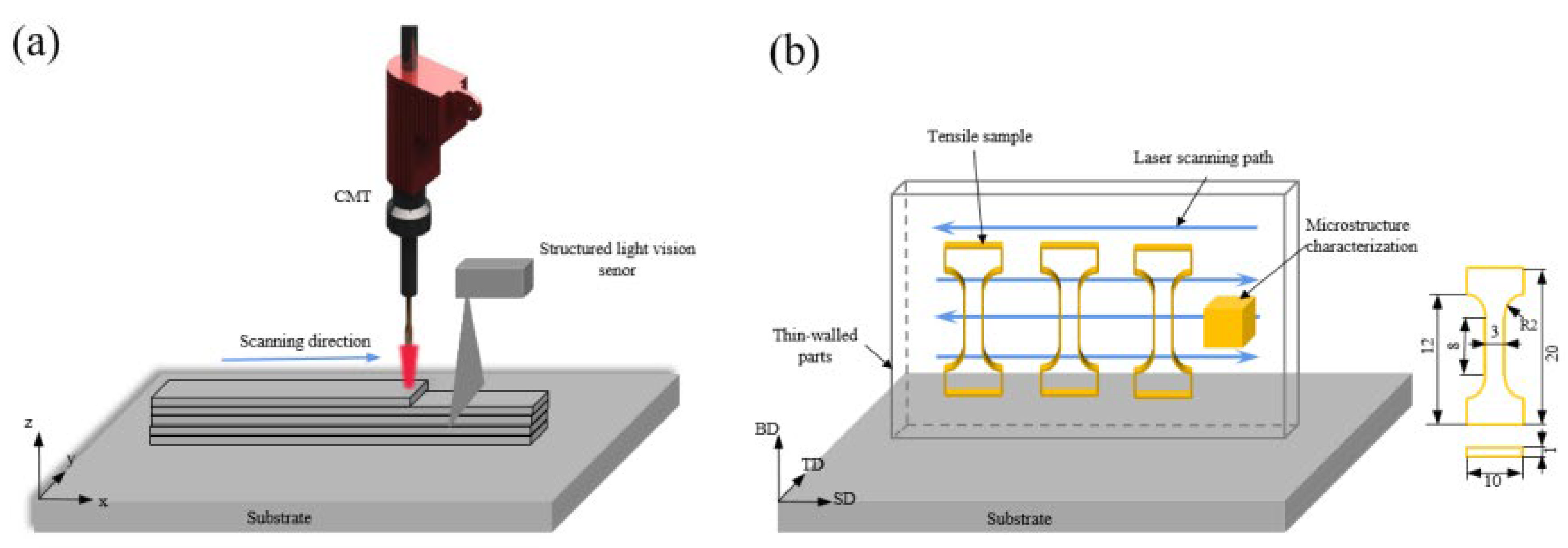


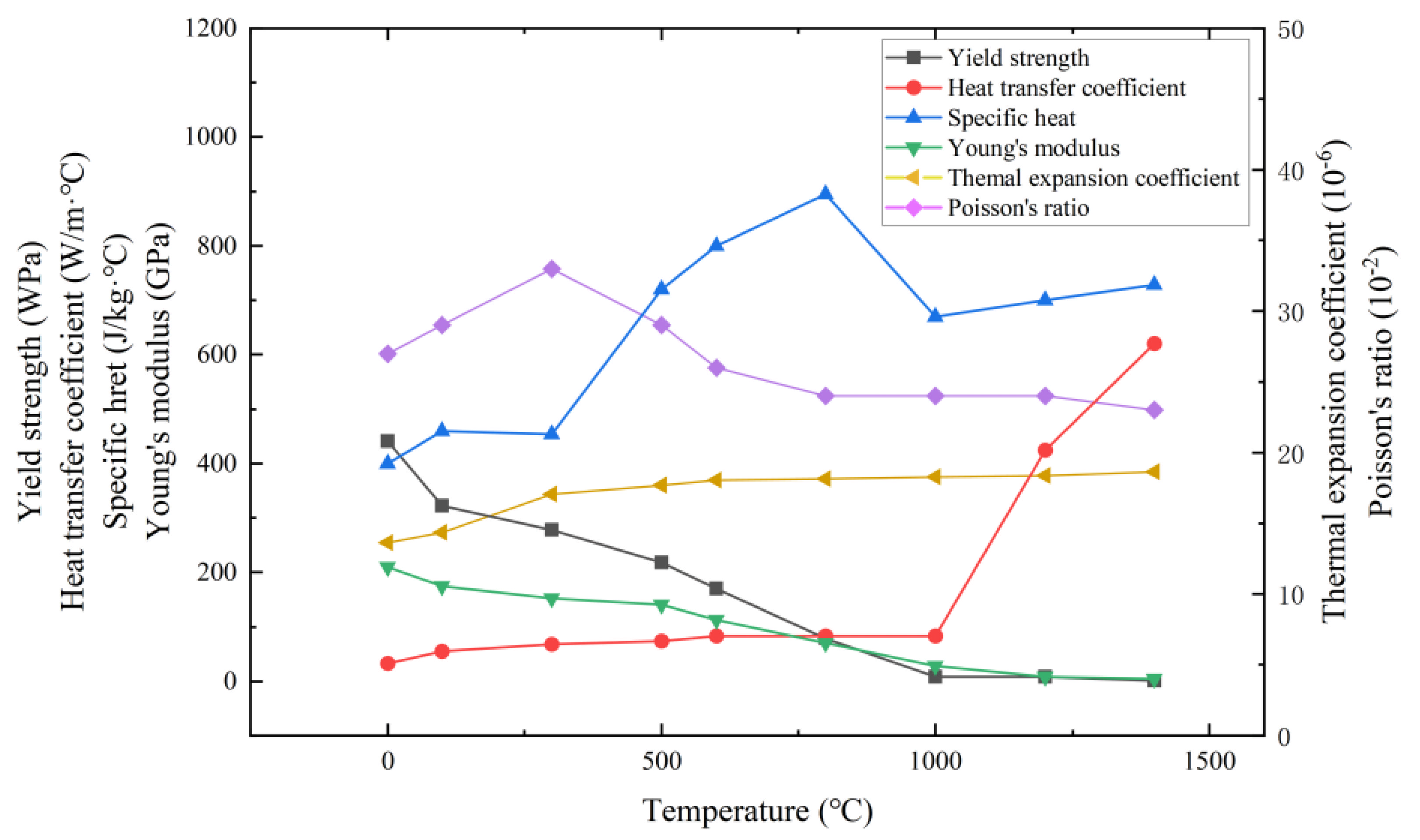


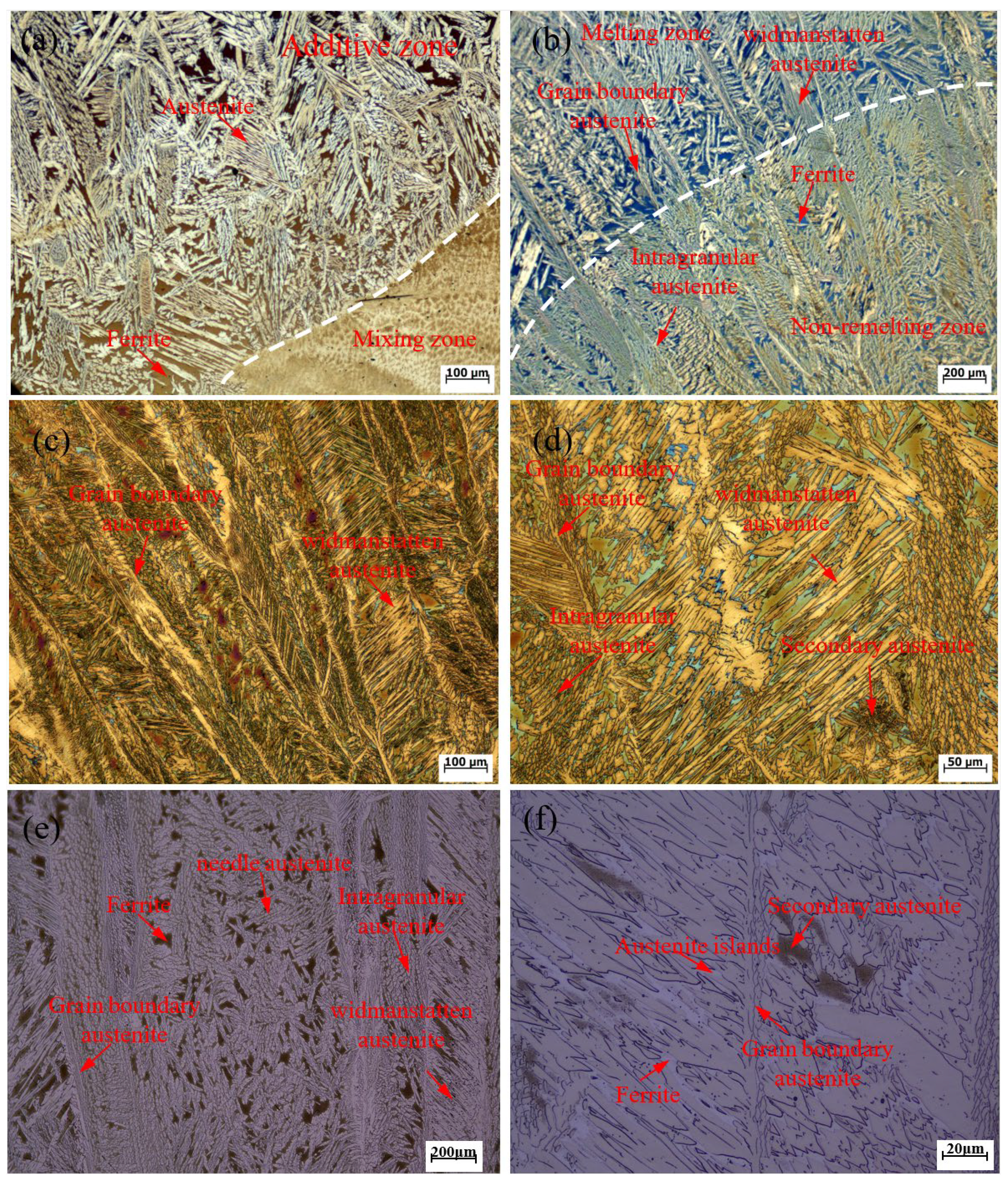

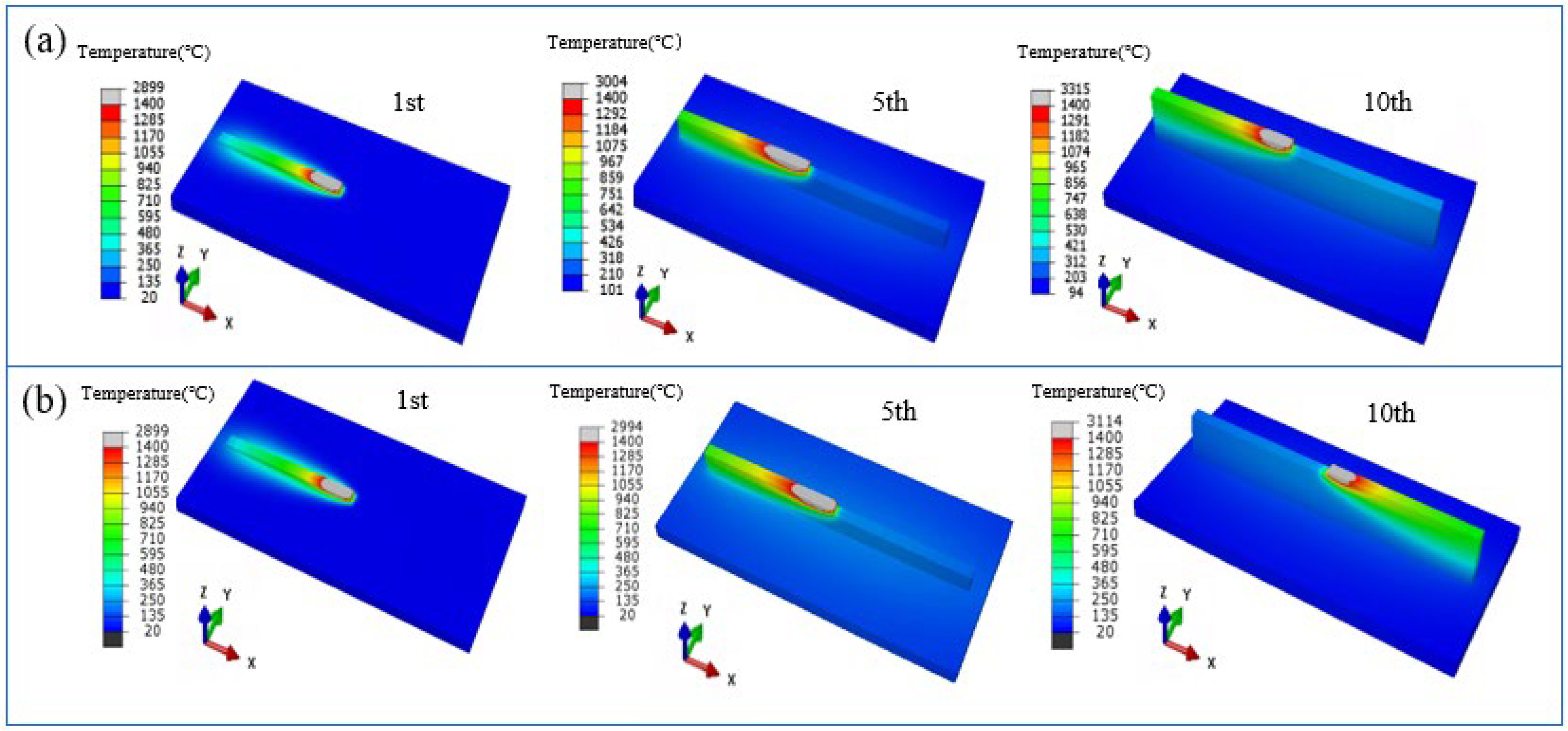
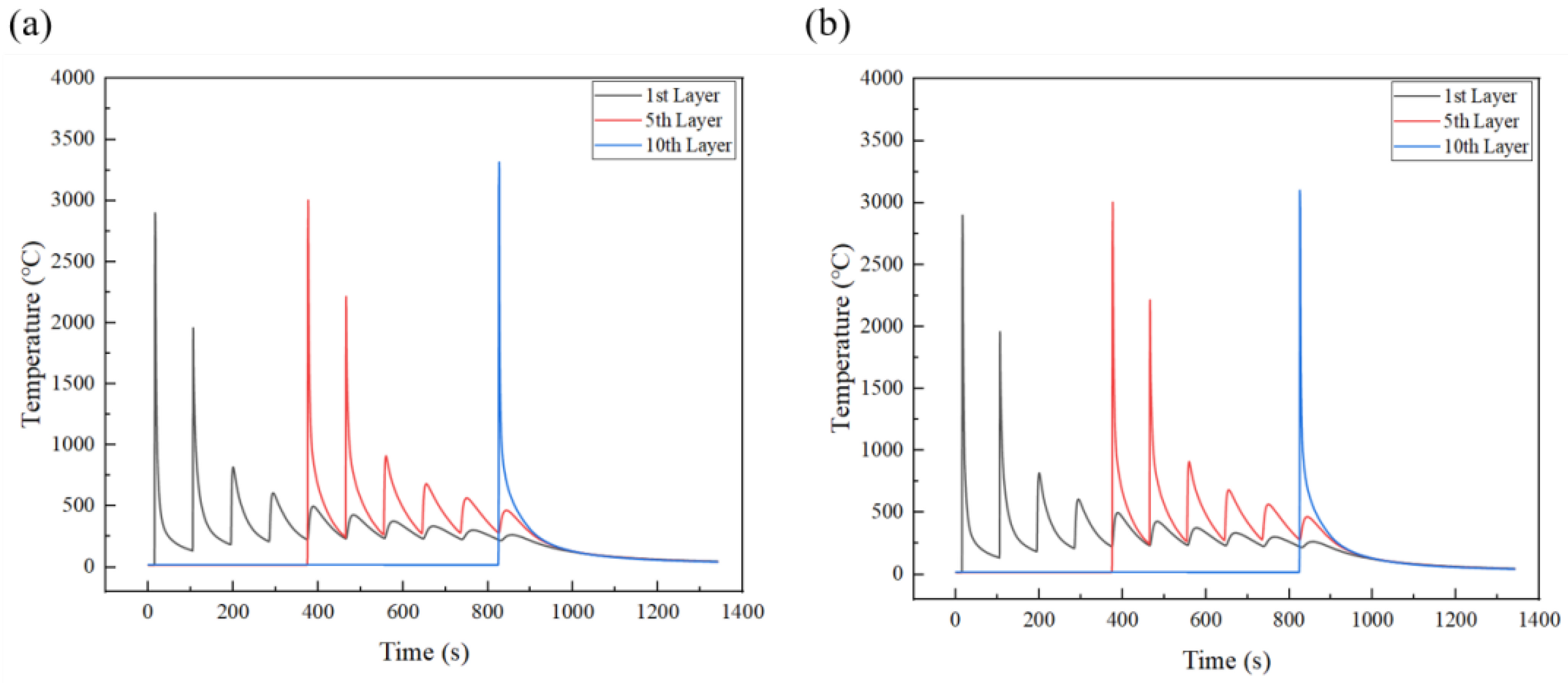
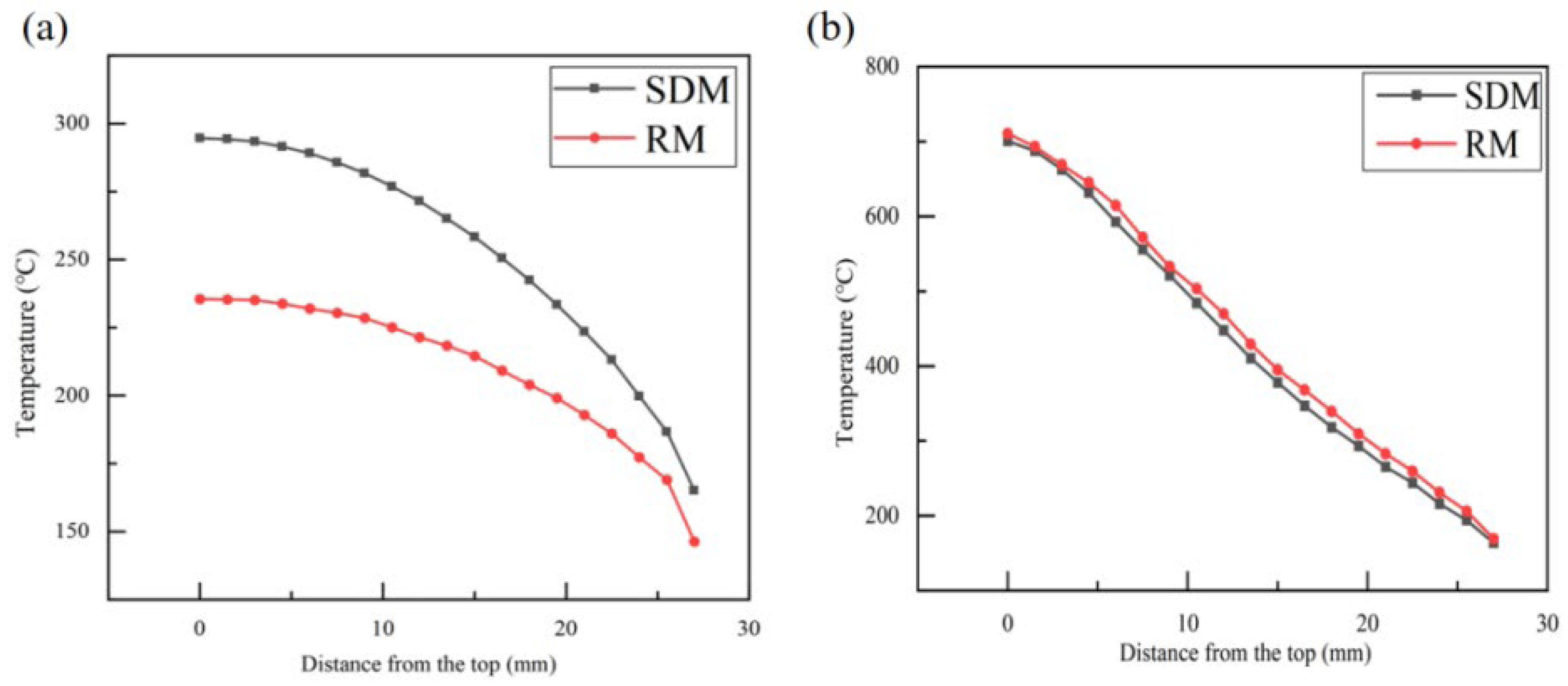


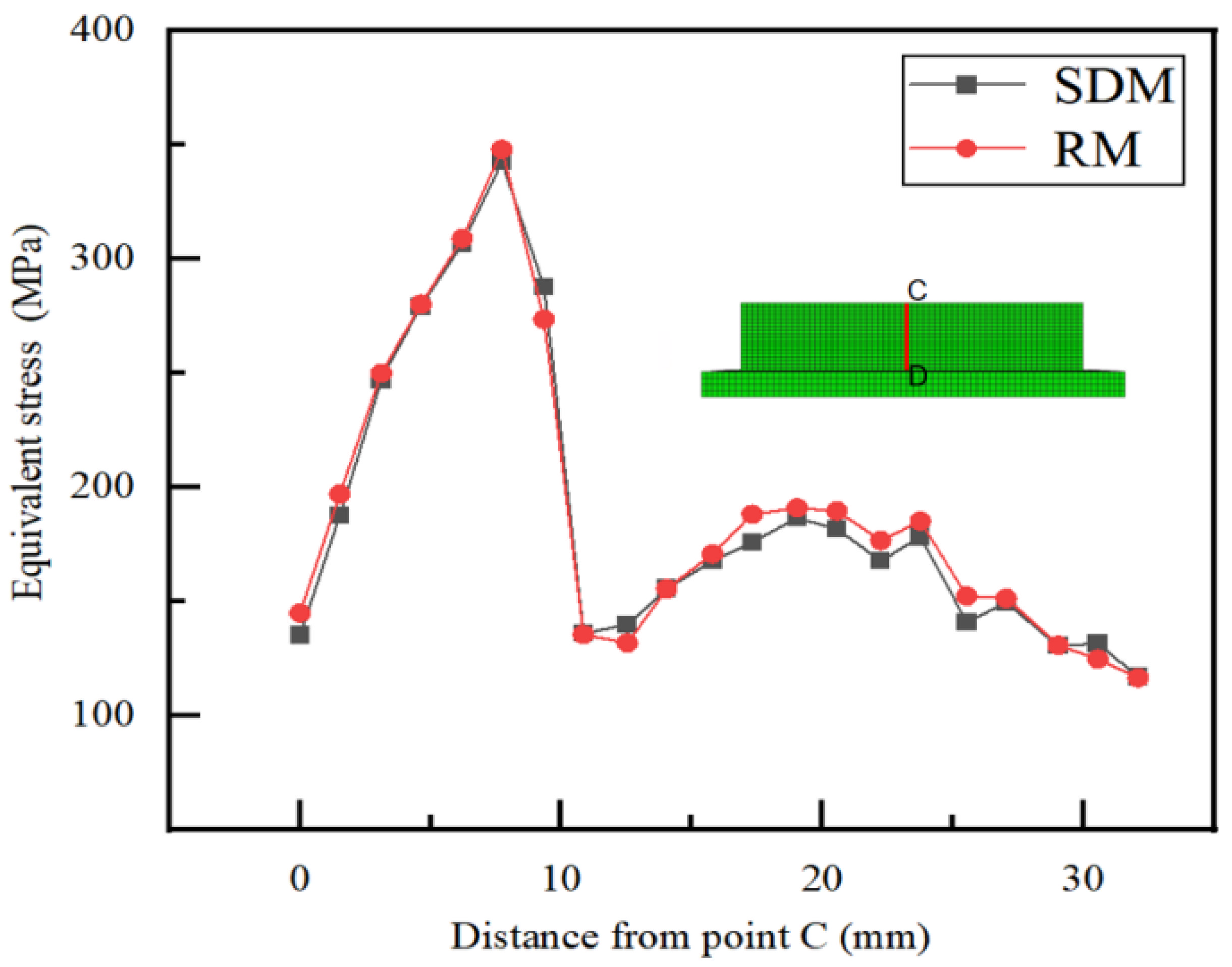
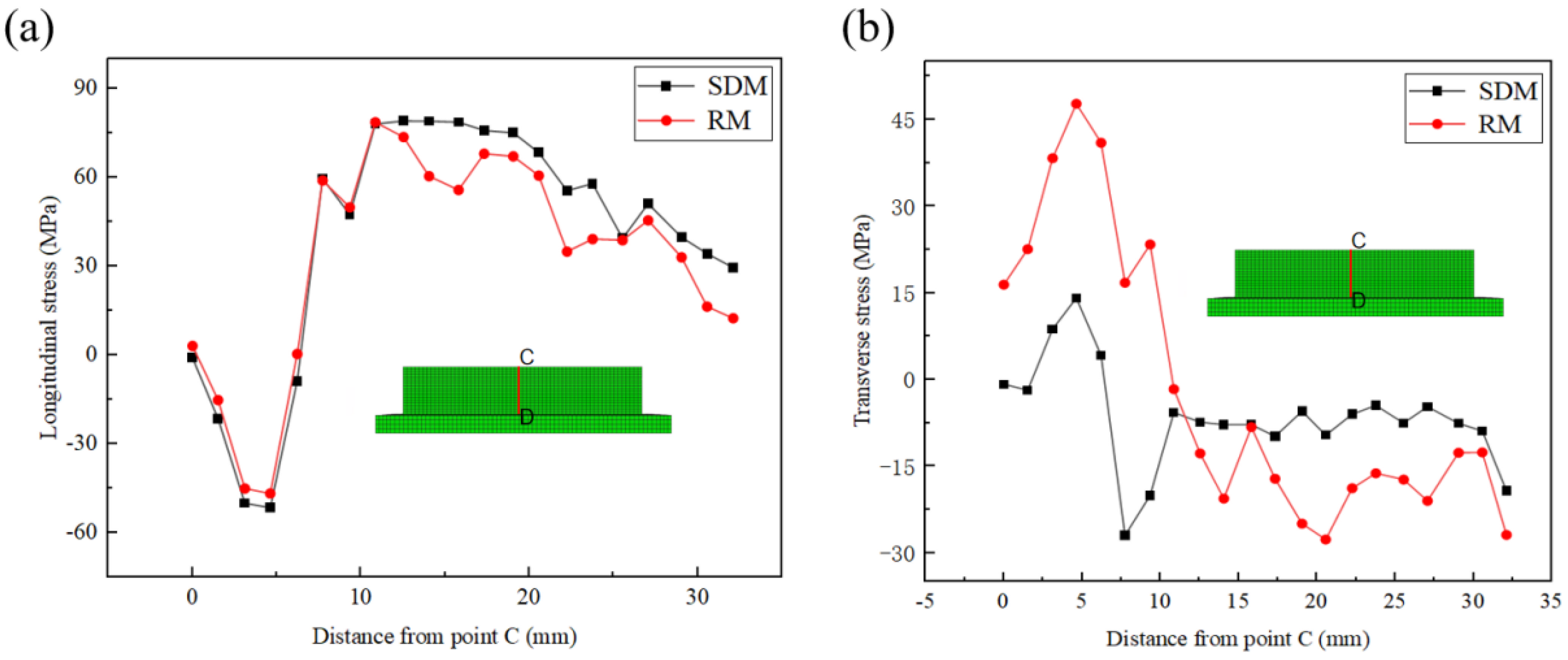
| Materials | C | Si | Mn | P | S | Cr | Ni | Mo | N | Fe |
|---|---|---|---|---|---|---|---|---|---|---|
| Q235A | 0.14~0.22 | ≤0.35 | 0.30~0.65 | ≤0.045 | ≤0.050 | - | - | - | - | Bal. |
| ER2209 | 0.013 | 0.49 | 1.54 | 0.018 | 0.007 | 22.92 | 8.6 | 3.2 | 0.17 | Bal. |
| Materials | ρ (g/cm3) | Modulus of Elasticity E (GPa) | Coefficient of Linear Expansion α (10−5/°C) | Yield Strength Rp0.2 (MPa) | Tensile Strength Rm (MPa) | Elongation δ (%) |
|---|---|---|---|---|---|---|
| Q235A | 7.85 | 200~210 | 12 | 235 | 370~550 | ≥25 |
| ER2209 | 7.98 | 190~210 | 13.7 | 450 | 620 | ≥25 |
| b (mm) | c (mm) | ||
|---|---|---|---|
| 3 | 6 | 4 | 4 |
Disclaimer/Publisher’s Note: The statements, opinions and data contained in all publications are solely those of the individual author(s) and contributor(s) and not of MDPI and/or the editor(s). MDPI and/or the editor(s) disclaim responsibility for any injury to people or property resulting from any ideas, methods, instructions or products referred to in the content. |
© 2022 by the authors. Licensee MDPI, Basel, Switzerland. This article is an open access article distributed under the terms and conditions of the Creative Commons Attribution (CC BY) license (https://creativecommons.org/licenses/by/4.0/).
Share and Cite
Yuan, Y.; Li, R.; Bi, X.; Gu, J.; Jiao, C. Experimental and Numerical Investigation of CMT Wire and Arc Additive Manufacturing of 2205 Duplex Stainless Steel. Coatings 2022, 12, 1971. https://doi.org/10.3390/coatings12121971
Yuan Y, Li R, Bi X, Gu J, Jiao C. Experimental and Numerical Investigation of CMT Wire and Arc Additive Manufacturing of 2205 Duplex Stainless Steel. Coatings. 2022; 12(12):1971. https://doi.org/10.3390/coatings12121971
Chicago/Turabian StyleYuan, Yuheng, Ruifeng Li, Xiaolin Bi, Jiayang Gu, and Chen Jiao. 2022. "Experimental and Numerical Investigation of CMT Wire and Arc Additive Manufacturing of 2205 Duplex Stainless Steel" Coatings 12, no. 12: 1971. https://doi.org/10.3390/coatings12121971






